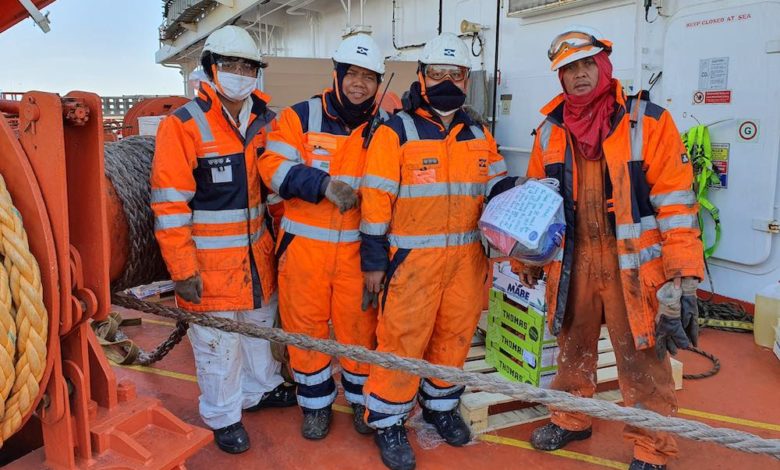Sharpening Poseidon’s razor

Newly released data clearly shows the better the welfare onboard, the better the condition of the ship. Steven Jones, the founder of the Seafarers Happiness Index, explains.
In our busy data-driven world we are constantly seeing facts emerge out of the fog of digitalisation. All kinds of weird and wonderful trends and correlations which were invisible, or perhaps unprovable, to our maritime industry forebears are now writ large shaping the industry.
Much of what is produced by shipping companies, across fleets, or churned out from ships, is about performance. What speed is this spinning, how much is this emitting, how much of this has been eaten, etc. How often are we late, early, on time, how many of these have we broken?
Data becomes the all seeing eye. Watching everything, always…and the minute an interested party interrogates it, then the “truth” emerges. What a time to be alive!
Where such facts have been harder to pin down has related to seafarers. The humans in our watery, steely, trade driven maritime equation. Yes, there are performance management tools, there are ways and means of knowing who is doing what with whom, and what did they say while doing it?
However, away from the Big Brother vibe, it has proven far more challenging to pin down the seemingly mysterious interplay between how people feel, what makes them feel this way, and whether good ships influence such moods.
Finally it seems we are edging to a better understanding, or certainly a more positive mechanism for bringing the magic three elements together in a meaningful, useful and informative way. With the latest data from the Seafarers Happiness Index combined with analysis by Idwal, we can now see the interplay between elements of crew sentiment and welfare provisions onboard ships, both transposed against the condition of the ship itself.
With this coming together of survey, data and dialogue we have suddenly come across a hooray, eureka and a-ha moment at the same time. It is finally possible to take what we probably all intrinsically suspected…that good ships are better for people, and people who experience better things are happier. Which granted seems a little trite and simplistic written down, but it is true. We can now explore the human and ship condition at the same time.
Now as with any of these things, the data analysts would couch everything with caveats and be-carefuls, but we can finally gauge a deeper understanding of the physical realities onboard, and this allows a real-world welfare picture to emerge.
Starting in Q2 2022 Idwal began exploring the welfare conditions of seafarers, using a new inspection approach which explored the crew welfare conditions onboard. As one of the lead Mission to Seafarers, Seafarers Happiness Index sponsors they were intrigued as to the interplay and plotted the results. What they found? Well, as the Crew Welfare Grade increases so too does the vessel condition, and vice versa.
I shall repeat for the avoidance of doubt about the alchemy we are seeing here…as the welfare increases the vessel condition increases too. Good ships, good times. There appears a definite and sustained trend/correlation between the overall condition of the vessel and the welfare conditions onboard.
Data scientists and marine surveyors being how they are, that seemed to be too simple and obvious. What, they asked, if we made it harder and the data is refined? To explore this, four generic vessel types – bulkers, tankers, containers and other (ro-ro, offshore, etc) were number crunched. Again…the same. The trend between the vessel condition and crew welfare persisted. Ok, let’s try again. What about more specific vessel types? So Idwal looked at SR tankers, mini-bulk carriers, and supramax bulk carriers. Would they show the welfare/condition correlation? Yes.
What about classification societies? Boom…the same. Ok, flag States? Same, same, same. It seems that whatever the interrogation, whatever the parameters, whatever the specifics, the better the welfare, the better the ship…and the better the welfare, the happier the crew.
The data steadfastly indicates a correlation between vessel condition and the crew welfare conditions onboard. This is extremely important when it comes to understanding the significance of seafarer welfare, and the role this seemingly plays in improving the standard of vessels.
Carve it up anyway you want, happy seafarers rest on good welfare, and that is either translated into higher quality ships, or ships improve as a result. This positive symbiotic relationship continues as we see seafarer happiness tracks higher with enhanced welfare standards. Indeed, where the quality of life and the experience onboard is better, then we see higher levels of satisfaction. As such, happiness becomes the ‘canary in the coal mine’.
Where we find happier seafarers we see better welfare standards, and where we see better welfare, we find higher standard ships. Let’s call it Poseidon’s razor…that all things being equal a good ship is good for crew.
For the data driven amongst you, the latest Seafarers Happiness Index figures show another rise in Q4 2022, with something of a high water mark being reached of 7.9/10. A rise driven by more certainty surrounding crew changes, small improvements in shore leave…but also a lot of seafarers moving to short sea or coastal trades to try and insulate themselves against risks of future travel bans and lockdowns. It will be interesting to see if that maritime migration trend continues…will the last one off the big ships turn the lights off? No, not the Nav lights, you fool.
To download the latest report, click here.
